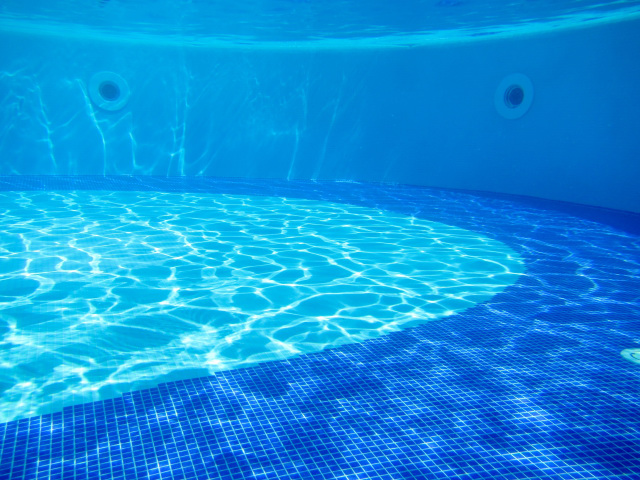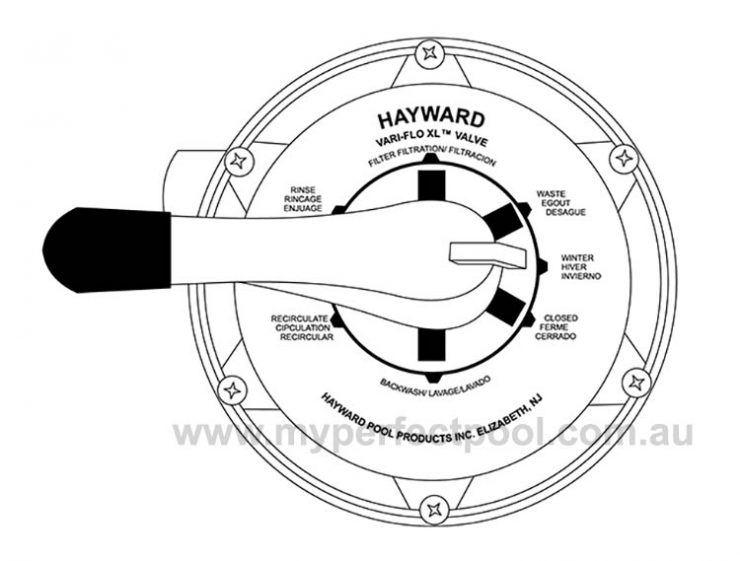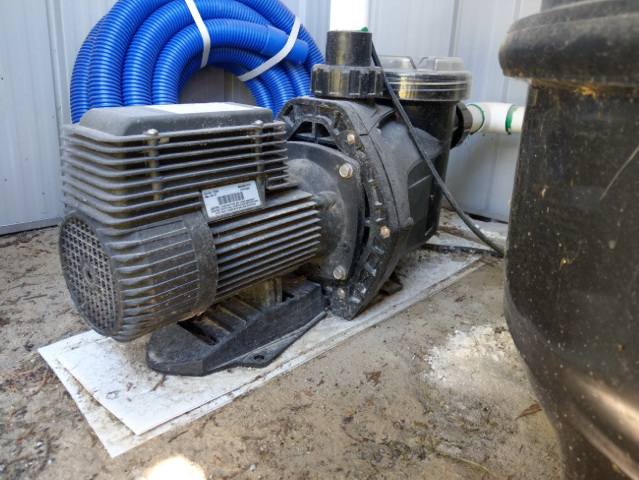Essential for the return of clean water back to the pool, a weak return jet or jet that is not working is the first sign of trouble in your return lines and pipes. So what causes this?
Usually, low pressure or no water coming out of the pool return jets is caused by an air leak in the system, a dirty filter, or blockage on the suction side of the pump. A faulty pool pump can also cause problems with return nozzles.
Now that was just a quick summary of the possible causes of your pool jet problems. Keep on reading for a detailed troubleshooting guide.

Article Contents
How Return Jets Work
Return jets form a crucial component of the highly interdependent closed pool circulation system.
The pool pump draws water from the skimmer into the filtration creating a negative pressure from the suction resultant positive pressure is then created in the pump itself which is used to push water back to the pool through the jets. Pressure alteration due to a malfunction at any point in the system may cause your jets to fail.
This article will aim at exploring possibilities of return jet failure and remedies on how to quickly fix that.
Why Are Return Jets Important
1. They Push Out Clean Filtered Water
Pool jets keep water in circulation. Dirty water is drawn into the filter via the skimmer, gets cleaned of debris and other dirt material, and is then pushed back into the pool through the jets (eyeballs).
2. Distribute Pool Chemicals
By circulating the water the jets ensure that pool cleaning components and sanitation chemicals are evenly distributed as the water circulates.
Jets act as the stir stick to help distribute chemicals in your pool.
3. They Prevent Buildup on Surfaces
As the water circulates, it prevents the piling up of debris or pool chemicals in one spot. This helps to minimize the staining of your pool.
Having movement in the water ensures nothing stagnates enough to cause damage i.e if the chlorine isn’t dispersed quickly in the pool, a high chlorine concentrated area of water could cause damage to the walls and metal surfaces. For pools with liners, the liner can be bleached and also weakened.
4. Helps to Move Debris into the Filter
Pools are designed to circulate the water around the pool and back into the skimmer. This circulation action helps to move any floating debris or suspended particles in the water back into the skimmer, where the filter can then remove it.
Removing debris and particles from the water is an important part of keeping your pool clean.
What Happens When My Return Jets Are Not Properly Working
Weak or failed return jets would simply mean your pool water won’t properly circulate. Without that pool circulation, the water will quickly grow algae, collect dirt, and become unswimmable.
How Can I Tell My Return Jets Are Weak?
The easiest way to test your pool’s jets is to turn the pump on and place your hands in front of each jet. If you have any of the following signs, then there is a problem:
- Weak flow (low pressure)
- No flow or water
- Excessive bubbles
- Low pressure reading
Normally, you’ll see your jets shooting powerful streams of water into the pool. However, when your return jets aren’t working, you start to get weak flow. This is characterized by return dribbling and the presence of bubbles. This can be enough to determine there might be a problem somewhere in one of the lines, in the pump or in the filter.
A weak jet will still blow but when you place your hand against it you’ll notice it’s blowing significantly weaker than other jets.
Low Filter Pressure Reading
Usually, your pool has a constant reading range from the first day of installment (pounds per square inch PSI). A drastic drop in level without you having changed the flow rate (Revolution Per Minute RPM) of your pump could provide you with a crucial lead as to why your jets are not properly working.
What Causes My Return Jets To Be Weak?
Weak pool jets are easy to determine but how easy is it to tell where the problem is exactly? This could be wide-ranging from:
- Low pool water level
- Dirty filter
- Incorrect multiport valve settings
- Broken multiport valve
- Pump failure to prime
- An air leak or water leak in the pipes
- Blocked or restricted filter
- Blocked or restricted skimmer basket
- Incorrect valve setting
Many of these issues are characterized by low or higher than normal pressure in the system.
How To Troubleshoot Pool Jets
1. Check the Water Level
The point of entry of water into the pump is the skimmer. The water level should be at least halfway up the skimmer’s mouth.
If it’s too low, it means less water flowing through your pump and filter. And ultimately this may mean low water flow from your return jets
If the water is low, you may hear a gurgling sound coming from the skimmer and that means the pump is taking in air and is having trouble priming.
Solution
Fill up your pool so the water level is at about halfway up the skimmer opening. Then start the pump and check if your jets are back to their normal pressure.
There’s a nice product on the market to maintain the ideal water level. It’s an automatic water level controller.
This handy product connects to your garden hose pipe. When the water is low, it will automatically fill up your pool. You can get it here:
- Automatically keeps pool water at your determined level
- No more manually filling up your pool
- Extremely high quality & long lasting
2. Check the Filter Pressure
The pool filter pressure should be regularly checked from the time of installation or after a cleanout.
Most manufacturers’ specifications give pressure ranges from between 13 and 16 PSI operating in a range of +/- 10 PSI. If your pressure is +/- 10 PSI outside your filter’s normal range, then you know something is wrong.
Common causes of filter pressure issues are:
- Pump not fully priming
- Low water level
- Clogged skimmer baskets
- Filter valve allowing water to bypass filter
- Air in the system
- Faulty pressure gauge
- Clogged or dirty filter
Solution
Regular maintenance that includes backwashing and filter media changes could help the buildup of clogs in your filter.
Here’s how to clean a cartridge filter: How to Clean Pool Cartridge Filter (Using Muriatic Acid)
Here’s how to clean a DE or sand filter: How to Backwash a Pool Filter & How Often
At the extreme, you can simply change the filter media (when sure you’ve run it for over 3 years).
3. Air in the Pool Pump
This means somewhere in the circulation system, air instead of water is being pulled in. An air leak is usually located on the suction side of the system (between the skimmer or main drain and pump).
How to Detect Air Leak in Pump
- Presence of bubbles shooting from the jets (weak jets) or the strainer.
- Look in the pump window, if there are lots of bubbles, you have an air leak somewhere.
What Causes Air to be Drawn in the Pump?
- Low Water Level – your pool will pull in air if there isn’t enough water in the pool
- Cracked Lines – when part of the plumbing intake or return lines buried underground breaks off.
- Faulty valves – As a result of repair or deteriorating gaskets inside the valves can let in air.
- Damaged o-rings – Check the pump lid and unions. These contain o-rings. You can also check the other joints in the plumbing.
- Loose Winterizing Drain Plugs – if these weren’t properly tightened, they can be a source of air leak.
How to Remove Air From Pool Lines
For optimum pool pump operation, the source of the leak must be identified and corrected. How?
- Always maintain pool water level – the ideal water level should be at least halfway up the skimmer intake.
- Check the rubber gaskets for cracks pinching the gasket that seals the pump strainer lid and replace them if there is any deterioration.
- Replace seals if broken for pump drain plugs and intake unions.
- Check out for damaged and brittle PVC plumbing and also glued joints like tees, elbows, and valve ports.
After fixing the air leak, check if your pressure gauge is reading stable and if the jets are good.
4. Clog in the System
A blockage in the suction line will translate to low jet pressure. This may be due to:
- A broken skimmer basket (this will let debris past and into the pump)
- Clogged up pump impeller
- Clogged main drain
You can easily detect this when the pump hums louder than usual, which means it is straining and an intake line may be blocked. Little water intake translates to little water output.
There is a possibility of the line or pipe between the return jet and the filter being clogged, but this is less likely. That’s because the water flows through the filter first before going into the return jets. So the chances of them being clogged are minimal since debris has been removed by the filter.
However, if there’s any blockage in the return you can try blocking the jet by hand to let the pressure build, then releasing it. It may clear the blockage.
How can I prevent clogging of your line?
- Regularly skim your pool with a scoop net.
- Get a skimmer sock for your pool skimmer.
- Vacuum clean your pool regularly.
- Clean out the skimmer and pump baskets regularly.
- Replace damaged baskets.
- Collect leaves, sticks, petals, dead insects & more
- Fits standard size (1-1/4") telescopic pool poles
- Deep bag to collect more debris
5. Incorrect Valve Settings
What if the low jet pressure is a result of a missed valve setting? Most filters especially sand and DE filters have a multiport valve.

The six settings of a standard multi-valve include:
- Backwash – Cleans the filter
- Rinse – Used after backwashing
- Waste – Used to drain the pool
- Filter – The normal setting to filter the water
- Recirculate –Used to direct the water to the return jets but not through the filter
- Closed – Terminates all flow
Verifying the proper valve setting is essential just to check it isn’t causing trouble. It’s an easy mistake to make.
You may also have other valves on your lines or pipes. Make sure these are set in the correct position.
6. Blocked Filter or Jet Line
Your pressure reading could be higher than the normal stable reading on your gauge and your jets are still weak.
If the pressure is high, it usually means your filter is blocked. It’s also possible there is a blockage between the filter and your return jets. This would cause no water to come out of the jets or weak pressure from the jets.
We have an entire article on how to fix blocked jets here: How to Unclog a Blocked Pool Return Jet (eyeball)
Solution
Start by making sure your pool is clean. Thoroughly clean your pool to get rid of the sediment and debris that makes your water murky. Sanitize your pool with sufficient chlorine to prevent the growth of algae that makes your water cloudy and then clean out your filters.
Next clean your filter.
For a cartridge filter, you can try an acid bath to clean it. Acid bath cleans the deepest crannies while for sand or DE filters, simply backwash or change the media.
However, you might notice the problem persists even after backwashing. To know if the filter media is causing the issue, set the filter to ‘recirculate’ to bypass the filter media. Check the system again. If pressure returns, then something is going on with the filter.
7. Too Many Water Features
If you have water features, pool heating, a spa, or other peripherals connected to your pool, it may simply be that your pump is not powerful enough.
Solution
Install a booster pump to increase the pressure in the system or switch off any unused extras.
8. Faulty Pump
Could Trouble in the pump be the Reason for Low PSI low Jet pressure?
If everything else seems to be ok, the problem may be with the pump itself.

Breakage in your pool pump can be the cause of your jet pressure problems. Before you completely invest in a new pump ensure you’ve checked:
- The condition of the impeller
- Cleaned the pump strainer
- Checked it doesn’t have an air leak
- Checked the lid seals tightly
Sometimes pumps can be repaired too.
Where Should You Aim the Jets?
Once you get your jets working again, you’ll want to adjust the aim. Don’t just randomly point them, as this isn’t good for the circulation of the pool. You want the jets to move the water around the pool in a circular motion. Here’s how to aim your return jets.
How Can Increase the Pressure of My Return Jets?
- Install more than one jet (to maximize on circulation).
- Ensure other pool components are well maintained (pool pump, skimmer, main drain).
- Correctly position and angle your pool jets.
- Ensure uniformity in size in jets closer to the skimmer and equally uniform size to those at the bottom.
- Install a booster pump.
- Turn off water features.
- Minimize peripherals such as pool heating and spas.



